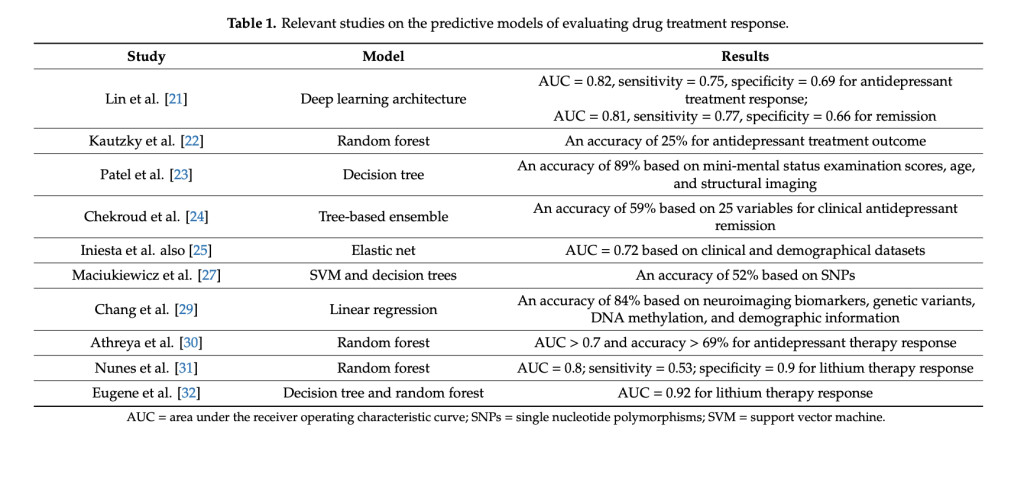Advances in Precision Psychiatry: Integrating AI and Machine Learning:
Precision psychiatry, merging psychiatry, precision medicine, and pharmacogenomics, aims to deliver personalized treatments for psychiatric disorders. AI and machine learning, particularly deep learning, have enabled the discovery of numerous biomarkers and genetic loci associated with these conditions. This review highlights integrating neuroimaging and multi-omics data with AI techniques to predict treatment outcomes, prognosis, and diagnosis and identify potential biomarkers. Despite significant progress, challenges remain in data biases and model validation. Future research must improve interpretability and extract biological insights to enhance predictive accuracy in clinical settings.
AI and Machine Learning in Predicting Psychiatric Drug Treatment Outcomes:
AI and machine learning are tools for predicting responses to psychiatric drugs, especially antidepressants and lithium. Like Lin et al.’s multi-layer feedforward neural networks, deep learning models integrate SNPs, demographics, and clinical data to predict antidepressant responses with high accuracy. Traditional machine learning methods, including random forests and decision trees, also show promise. For example, Kautzky et al. used random forests to identify genetic and clinical predictors of antidepressant response, while Eugene et al. employed decision trees and random forests to predict lithium treatment outcomes based on gene expression. Despite progress, more human studies are needed to refine these predictive models.
AI and Machine Learning in Prognosis Prediction for Psychiatric Disorders:
Based on current patient data, AI and machine learning are used to predict future medical outcomes for psychiatric disorders. Schmaal et al. used Gaussian process classifiers with MRI and clinical data to predict MDD trajectories with 73% accuracy. Deep Patient, a deep learning model using EHRs, predicts diseases like ADHD and schizophrenia with high accuracy (AUC = 0.85). Deep Patient outperforms conventional methods due to its non-linear transformations. Other tools like DeepCare and Doctor AI, using recurrent neural networks, further support prognosis prediction by handling irregularly timed events in EHRs.
AI and Machine Learning in Diagnosis Prediction for Psychiatric Disorders:
AI and machine learning methods are increasingly used to diagnose psychiatric disorders like Alzheimer’s, autism, and schizophrenia using neuroimaging data. For instance, SVMs and deep learning models, such as auto-encoders and deep belief networks, have shown high accuracy in distinguishing between healthy individuals and those with Alzheimer’s or autism. Deep learning models have also outperformed traditional methods in early diagnosis. Additionally, combining SNPs and protein data with ML techniques like logistic regression and naive Bayes has improved the prediction of schizophrenia, demonstrating the potential of AI in enhancing diagnostic accuracy.
Limitations of Current AI and Machine Learning Approaches in Psychiatry:
Current AI and machine learning studies in precision psychiatry face several limitations. Small sample sizes risk overfitting and limit generalizability to diverse populations. Many studies need more replication with large-scale, varied cohorts, making their findings less universally applicable. Some models are specific to particular treatments and lack generalizability to other medications. Data heterogeneity and missing data further complicate the analysis. Long-term disease trajectories often must be addressed due to reliance on retrospective data. Research should focus on larger, prospective studies, improved data harmonization, and transparent, generalizable predictive models to enhance the field’s robustness and applicability.
Conclusion and Future Directions:
Precision psychiatry holds promise for advancing diagnostic and therapeutic strategies by leveraging AI and machine learning for personalized treatment, prognosis predictions, and biomarker detection. Future research should prioritize integrating multi-omics and neuroimaging data to enhance understanding psychiatric disorders. With the growing impact of data-intensive technologies and single-cell sequencing, new AI frameworks, particularly deep learning algorithms, are expected to revolutionize public and global health. The future will likely see the implementation of pre-treatment prediction tests in clinical care, driven by large-scale, prospective studies that refine biomarkers and clinical factors for individualized treatment plans.
Check out the Paper. All credit for this research goes to the researchers of this project. Also, don’t forget to follow us on Twitter and join our Telegram Channel and LinkedIn Group.
If you like our work, you will love our newsletter..
Don’t Forget to join our 47k+ ML SubReddit
Find Upcoming AI Webinars here
The post Advancing Precision Psychiatry: Leveraging AI and Machine Learning for Personalized Diagnosis, Treatment, and Prognosis appeared first on MarkTechPost.
Source: Read MoreÂ

